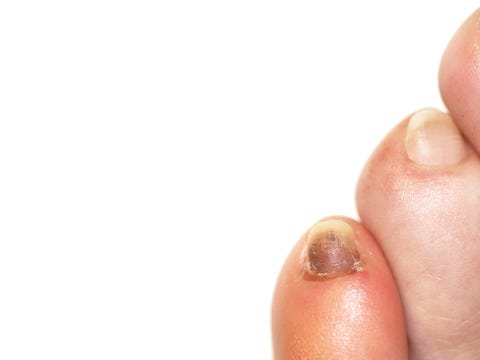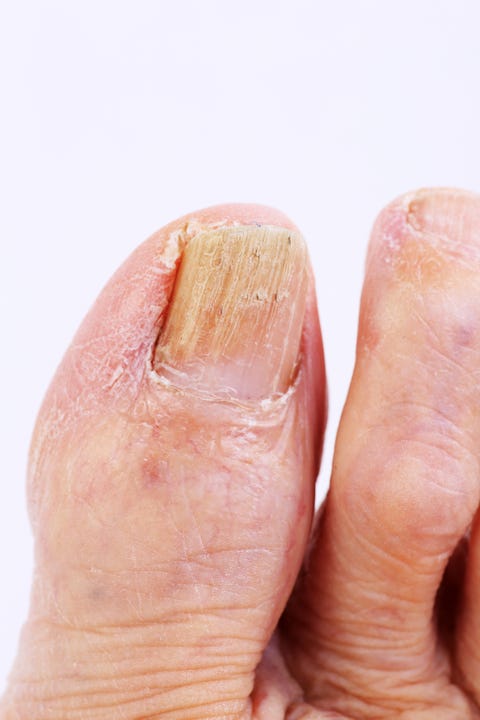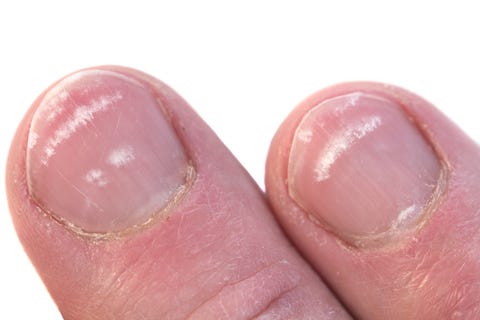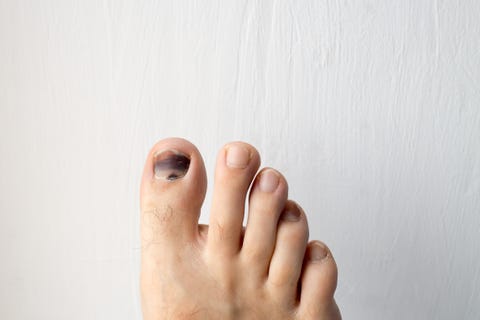

Every once in a while, you should take a good look at your toenails. You might joke about how your feet aren’t so pretty — especially if you’re a CrossFit junkie or get bruised nails from long-distance runs — but a less-than-desirable toenail appearance can actually be a sign of an underlying health issue.
“Healthy nails have a plump, pink nail bed and pink nail plate with strong but thin nails,” says Dr. Dana Canuso, podatric surgeon and founder of Dr. Canuso Skincare for Feet.
Here’s a guide to what the color of your toenails means, and what you should do if they start looking funky.
If your toenail is…purple

Getty ImagesANGHI
If your toenails are purple, this may be due to a subungual hematoma, or bruising under the nail bed. “Small blood vessels bleed underneath the nail staining it darker,” says Dr. Miguel Cunha, founder of the NYC-based Gotham Footcare. “This is caused by trauma to the nail, such as dropping a heavy object or severely stubbing it.”
When this type of bruising occurs, you have two options. The first is to do nothing and simply allow the healthy nail to grow back in and gradually replace the darkened nail over time. But this can take “several months to resolve, as the toe nails only grow a millimeter per month,” he says.
The second option is to have a doctor remove the nail. “This option is only necessary if the nail becomes painful, which can happen sometimes if the pressure of blood accumulating underneath the nail plate becomes abnormal and excessive,” he says.
Purple nails can also signify a circulation issue “that is causing the nail to receive less oxygen than it needs,” says Canuso. “Because the tissue may be not getting the blood it needs, there may be pain in the toe or nail.” To treat these symptoms, you must treat the cause of the circulatory issue, which usually means a trip to your doctor.
If your toenails are…yellow or brown

Getty ImagesWarren_Price

“Yellow or brown nails could be caused by a problem with the respiratory system or lymphatic system, although they occur most often due to complications of diabetes or even more commonly, nail fungus,” says Canuso.
When caused by a fungal condition, the nail will also be thick and brittle. “This is caused when a microscopic fungus infects one or more nails. These microscopic organisms typically thrive in dark, warm, and moist environments,” Cunha says.
It can happen from wearing moist sneakers or wearing the same pair for too long. “The insides of shoes are a perfect environment to harbor fungal organisms. This condition often begins as an infection in the skin, which is commonly referred to as athlete’s foot,” he says. As the nail fungus penetrates deeper into the nail, it may cause the nail to discolor, thicken, and develop crumbling edges
Treatment of this condition depends largely on the severity of the infection, but your doctor can do a nail biopsy to figure out what to do next. “Medicated antifungal nail lacquer may be prescribed for a localized mild to moderate infection. Prescription oral antifungal medications may be prescribed for a more serious infection,” Cunha says. Laser nail treatment is an alternative to oral medication, in which the laser passes a light through the toenail to kill the fungus without causing damage to the nail or the surrounding tissues.
If your toenail is…white or has white spots

Getty Imagesdeepspacedave
Leukonychia, or white spots or lines on the nail, can indicate several conditions. “White lines can appear if there is recurring pressure or trauma to the nail — for instance, if a runner wears shoes that are too small and the toe continues to hit the top of the shoe,” Cunha says. White spots will form if the injury was not severe enough to break the blood vessel, which would lead to darkening.
Leukonychia can also stem from a zinc deficiency, says Canuso. If the nail is completely white, or there are white lines across the nail bed, it “can mean anemia or a protein deficiency,” she says.
If the white spots are caused by injury, try taking a nail-fortifying vitamin like biotin to improve hair, skin, and nails — and of course, you should stop doing whatever traumatic activity you’ve been doing. “Be patient and simply allow the healthy nail to grow and gradually replace the white nail over time,” Cunha says. This can take several months to resolve, as toenails typically grow only about a millimeter each month.
If you are concerned you’re anemic, watch out for other symptoms such as fatigue or muscle weakness. “These could be symptoms of protein deficiency or anemia, and you should consult your physician,” Canuso says.
If your toenail is…all black

Getty Imagesavtk
“Nails that are completely black in color may have numerous causes, such as a B12 deficiency, kidney problems, or liver disease. But the most common reason for the discoloration is trauma,” says Canuso. Simply stubbing your toe can cause a bruise to form under the toenail, which in turn can turn your nail black.
If this happens, you must wait for the entire nail to grow out before the discoloration is gone, which can take about six to nine months, she says. If you’re concerned about any of the above conditions, consult with a physician, but rest assured that these are relatively rare.
If your toenail isn’t black, but has a black stripe running across it, the most common cause is a condition called linear melanonychia. “This condition occurs when pigments in the nail known as melanocytes make excess pigment, causing the nail beds to darken,” Cunha says.
Source: Read Full Article